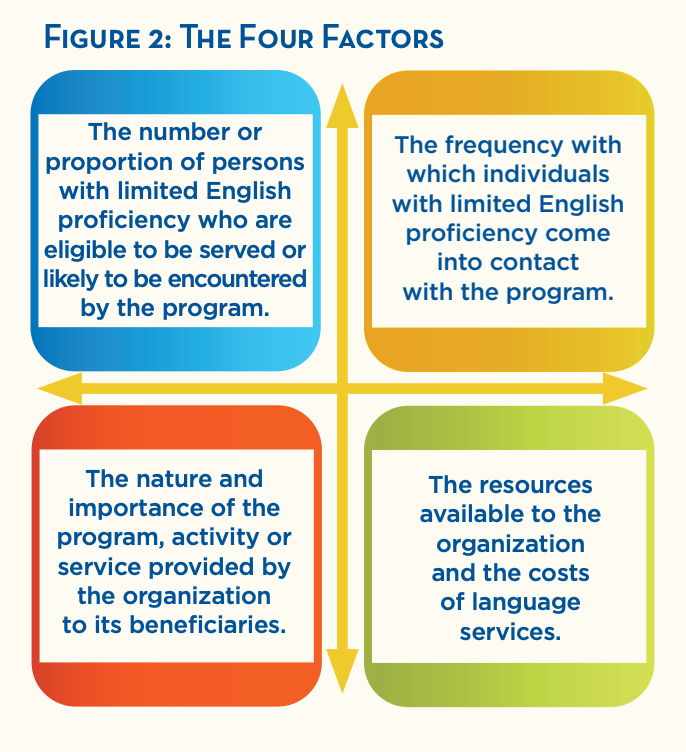Common Components of a Language Access Plan
In the US, everyone has the right to language access. Having language access for those with Limited English Proficiency (LEP) or other communication challenges helps to reduce disparities within social determinants of health and provide equal opportunities for those who have historically been marginalized.
Over time, laws have been put in place to address language access. Some of the federal laws that pertain to language access include:
- Title VI of the Civil Rights Act of 1964 – prohibits discrimination on the basis of race, color or national origin (speaks to language).
- Americans with Disabilities (ADA) Act 1990 – includes language access that involves communications for individuals who may be deaf, hard-of-hearing, blind or have other disabilities.
- Executive Order 13166 – in 2000, President Clinton signed an executive order that requires federal agencies to develop a systematic plan for meaningful for LEP individuals.
So where does a language access plan fit in? A language access plan is a policy that an organization creates to discuss how they intend to provide language services to those individuals who are:
- Non-English speaking
- Have LEP
- Have a visual impairment
- Are deaf or hard-of-hearing
- Have other challenges that make it difficult to communicate
A language access plan is a blueprint for an organization to outline and share its strategic approach for meaningful communication with those who need additional language services. It can include creating materials in other languages, interpretation and/or other communication paths. Some organizations, such as schools, healthcare providers, and government agencies, must provide a language access plan. For other organizations that provide services for LEP communities or individuals with other communication challenges, having a language access plan is a benefit and guidance for these services.
While there isn’t a single method to follow, we have identified common components. We’ll share those in this blog.
Common Components of a Language Access Plan
Based on publicly available government agency plans, organizations typically include the following components.
Needs Assessment
The first section is usually a needs assessment that explains how an organization will assess the language assistance needs of the communities it serves. An organization can analyze these needs in a variety of ways:

- Internal customer satisfaction surveys
- 2020 census results
- American Community Survey results
- Four Factor Analysis
- For other resources, look at the Centers for Medicare and Medicaid’s Inventory of Resources
- Other local resources such as health services, non-profit organizations, and others
Based on the findings, the organization will gain insights and predictions to help the quality and breadth of its necessary linguistic reach.
Language Access Coordinator
A designated language access coordinator(s) is one who will be responsible for the language assistance needs, such as:
- Developing the language access plan
- Training staff on the organization’s policies and procedures to ensure the integrity of the plan, and reiterate the organization’s mission. Those who work directly with customers and service providers should receive additional training on how to coordinate and communicate the services effectively
- Communicating the organization’s strategy and capabilities
- Managing language assistance services
Partnerships and Other Ties to the Community
In addition to the language needs section, this section lists community leaders, stakeholders, and groups that work with LEPs or LEP communities. These organizations can be useful to get feedback, assess quality, determine priorities, get data about experiences, and more.
Interagency, Liaison or Working Group Cooperation
Provide names of advisory committees, working groups, forums, resource sharing, and partnerships with other agency networking options to gain insights, information, tactics, and pool resources.
Meaningful Marketing, Information, and Communications in Print and Online
Add information dissemination methods that reach multiple channels in print, digitally, onsite or otherwise. Participate and partner with organizations, programs, events, public meetings, key community stakeholders, social media, and more to ensure the communities have the information.
Quality Control
Provide ways in which you plan to clearly track the quality of the language assistance. This can be done in a variety of ways, including an internal audit with reports; reviewing data from the LSP regarding complaints, timeliness of the deliverables or other success metrics; having the community stakeholders review content; or interagency/working groups review content to make sure the translations are accurate. In addition, provide how to onboard, gather customer feedback, track data, establish partnerships, maintain linguistic assets, and more.
Tracking and Reporting Data
Describe how you’ll track language service usage over time, primary and secondary languages, and initial data intake from LEP individuals. In addition, know what tracking systems are available to you through overarching or interagency organizations.
Additional Components to Consider
Additional line items that we’ve seen but less frequently include:
- Multilingual planning for disaster/emergency preparedness
- Resource utilization to include who is involved with language assistance and tracking effectiveness
- Budgeting approaches
- List any centralized internal contacts for language services such as the LEP coordinator, language services procurement official, or otherwise.
- Clear descriptions of the types of language services provided
- Clearly identify each vendor’s Project Manager for placing language service requests
- Information on obtaining a language service provider (LSP) vendor through procurement and purchasing
- Information on the use of plain language
- Information on the inclusion of digital literacy efforts
Conclusion
The contents of a language access plan vary, as it’s really an individualized document for an organization. However, the components that we’ve shared in this blog post are quite common.
An LSP can be a partner and consultant in helping you develop and execute a language access plan. An LSP can help you strategize about making your plan more efficient, saving you money and time, reducing risks, and increasing service quality. So take advantage of what your LSP, plus your resources and network, can offer.
To learn more about how we can help you with your language service plans, contact us at [email protected] or (530) 750-2040.